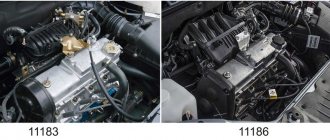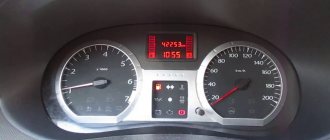Many car enthusiasts are familiar with the problem when vibration occurs when accelerating. There are many reasons for this phenomenon. Often, searching for a source can even drive a car enthusiast crazy. Let's look at the main reasons for shaking, because you really want the car to drive quietly and smoothly. In 75% of cases, the problem is detected and fixed, and the car owner can again feel calm and comfortable.
Steering wheel shakes when accelerating
Quite often, when driving, a strong vibration occurs on the steering wheel when accelerating. At first it is barely noticeable, but over time it becomes more noticeable. This can cause serious damage and lead to an accident.
The first thing you need to do is check the wheel balancing. To do this, you can go to the nearest tire repair shop. If your wheels are out of balance, then this is one of the popular reasons for shaking when accelerating. Fixing the problem won't cost much. Sometimes the disc becomes clogged with dirt or snow, then these beatings can occur and stop. It is very easy to determine the presence of dirt with alloy wheels, but with steel wheels, where the ventilation holes are small, it is difficult. Dirt collects inside the part.
How to eliminate floating idle speed on Lada Largus
One of the shortcomings that was noticed by owners of Lada Largus cars is floating speed after starting the engine in the morning. A long search for the cause of the unstable operation of the power unit led to the throttle assembly. It turns out that the whole problem lies in air leaks through the connections of the intake receiver and the remote control.
To troubleshoot the problem we will need:
- Ratchet heads for 6 and 8
- Torx key T-25
- Neutral sealant (odorless)
- FUM tape with a thickness of 0.075 mm, which is used by plumbers to seal threaded connections.
- Silicone Grease
- Clamp with screw tensioner 22x27 to strengthen the idle air channel hose
The need for balancing
Neither tires nor wheels are perfect in terms of geometry and composition. So, due to different masses in different parts of the wheel, those places where the weight is greater will pull the wheel axle towards themselves. At high speeds, the force will be transmitted to the rods, then to the steering wheel.
It is very important to perform balancing from time to time. Especially after changing tires or wheels. Using this procedure, you can equalize the masses of the wheels at each point. Driving a vehicle with unbalanced wheels can cause rapid wear on the chassis and suspension, a problem that is more difficult to correct.
Lada Largus float revs
Lada Largus. Engine speed jumps at idle
Engine speed jumps (floats)
Floating idle speed is a fairly common malfunction on various cars. The revolutions fluctuate on gasoline cars and diesel units, as well as on engines with gas equipment. Note that the idle speed on gas or gasoline fluctuates quite often due to third-party incorrect ECU firmware. While driving, this problem can cause a lot of inconvenience, since the driver is forced to constantly apply gas to prevent the engine from stalling at the most inopportune moment. Next, we will look at why the engine speed jumps at idle, as well as how to determine the cause of the problem for further elimination.
Unreliable wheel mounts
This problem is also easy to fix and diagnose. This is a simple but very dangerous reason. The fastenings can be loosened even on one wheel, and this is enough to cause shaking. If the problem is not resolved in time, emergency situations may occur. If the wheel falls off while driving, the repair will be quite expensive - you will have to replace the disc and hub, and the brake disc.
The symptoms in this case are very similar to vibrations due to tires or bent wheels. But there is a cyclical pattern here, although not at all speeds.
Spare parts, maintenance
Products from the Dustershop77 range that may be of interest to you:
| Name | Manufacturer | Price | Availability | Add to cart |
| BR-001-GARD-URDP | Mud flaps enlarged (widened) Duster-GARD front | Duster-Guard | 1500 / 1200 rub. Discount: 1000 rub. | >10 |
| DC495 | Discount card (Dusterclubs.ru, Dustershop77.ru) | 700 / 500 rub. Discount: 500 rub. | >10 | |
| DC218 | Air deflector “Warm feet” for Duster, Logan, Sandero, Largus | 900 / 350 rub. Discount: 250 rub. | >10 | |
| DC654 | Frill with fastening without 3M tape (Duster/Terrano) (ArtForm) | ArtForm (Yuago) | 3000 / 2000 rub. Discount: 1600 rub. | >10 |
| PT014-RDU112901 | Trunk sill trim PTGroup | Pt GROUP | 1200 / 1000 rub. Discount: 900 rub. | >10 |
| 005-008502 | Trunk sill protection | Russian Artel | 1400 / 1100 rub. Discount: 1000 rub. | >10 |
| DG-006-GARD-RDSHCH | Front diffusers - aerodynamic flaps Renault Duster (set of 2 pieces) | Duster-Guard | 700 / 600 rub. Discount: 500 rub. | >10 |
| R12711 | Wind deflectors (window deflectors) COBRA/Autoplex | COBRA/Autoplex | 2000 / 1600 rub. Discount: 1500 rub. | >10 |
| NRD-009102 | Frill under the windshield (RA) | Russian Artel | 2500 / 2100 rub. Discount: 1800 rub. | 5 |
| DC1024-V117 | Windshield and roof edge seal | Duster-Guard | 700 / 500 rub. Discount: 300 rub. | >10 |
Checking the suspension and chassis
Vibration when accelerating can occur as a result of natural wear and tear on the struts or shock absorbers. The suspension stops working smoothly, which is one of the causes of the problem. This can be especially noticeable on rough roads or when driving at speed.
Another popular cause of shaking is the support bearing on the strut. This part can be found on top, above the shock absorber. It is also checked under the hood from the front. If you can find a worn bearing, you should replace it, and then the problem will be solved.
Ball joints in most cases wear out due to driving on poor quality roads. In our country, these parts need to be changed very often. If you find play in the supports, then perhaps by replacing it you will be able to regain your comfort.
Check and, if necessary, replace the tie rod ends. Over time, play appears in this mechanism due to wear. Thanks to this tip, the car's wheels can turn parallel. Worn tips cause shaking.
Idle air regulator with cover 16V 8200692605 for VAZ Largus
Dear customers, in order to avoid errors when sending the electronic idle speed regulator 8200692605, in the “Comment” line, indicate the number of valves and engine size, your car model, modification KS015, KSOY5 (5-seater station wagon), RS015, RSOY5 (7-seater station wagon). mi local), FS015, FSOY5 (van).
The K4M engine is a gasoline, four-stroke, four-cylinder, in-line, sixteen-valve, with two overhead camshafts. The operating order of the cylinders is: 1–3–4–2, counting from the flywheel. Power supply system – distributed fuel injection (emission standards Euro 4).
When the K4M (16V) engine is idling (the throttle valve is closed), the electronic engine control unit (ECM) 8201264001 RENAULT controls the air supply using the idle air regulator IAC 8200692605.
Air from the air filter housing 1, having passed through the IAC 2, is supplied through a rubber hose 4 to pipe 5 of the oil separator housing and from there, through the air channel in the oil separator housing, enters the receiver 3.
Electronic idle speed regulator 8200692605 (IAC) Lada Largus is mounted on the air filter housing. IAC is a stepper motor with a micrometric screw (valve). The valve shut-off element (needle) changes the flow area of the channel and provides regulation of air flow bypassing the throttle valve.
To increase the crankshaft rotation speed at idle, the ECM sends a control signal to open the valve, increasing the air supply bypassing the throttle valve, and, conversely, to reduce the rotation speed, a command is sent to close the valve. When braking the engine, the throttle valve closes sharply, and the IAC increases the air supply bypassing the throttle valve, resulting in a leaner fuel mixture. This helps reduce emissions of hydrocarbons and carbon monoxide into the atmosphere.
The idle air control is non-separable and must be replaced if it fails.
Other article numbers of the product and its analogues in catalogues: 8200692605.
Lada Largus (4601), RENAULT Logan, Sandero, Duster.
How to independently replace the electronic idle speed control with a cover in a car of the Lada Largus K4M (16V) family.
With the online store Discounter AvtoAzbuka, repair costs will be minimal.
Just COMPARE and BE SURE!!!
Don't forget to share the information you find with your friends and acquaintances, as they may also need it - just click one of the social networking buttons below.
Engine mounts, gearbox mounts and other reasons
This is another possible group of reasons why a car may shake when accelerating. All these problems can arise for various reasons. For example, as a result of examinations, a breakdown of one of the power unit airbags is discovered. It's easy to find out - increase the engine speed when vibrations appear.
Body vibration when accelerating from 80 km/h to 100 km/h can also occur if there is a problem with the gearbox. Testing this hypothesis is very simple. It is recommended to reach a speed of about 85 km/h, then depress the clutch pedal and watch how the car behaves. Engage third gear and release the clutch. Accelerate from 50 km in the last gear of the transmission.
If the nature of the beats does not change during all these events, the gearbox is not to blame. If the vibration level increases when the box is connected to work, then you can check its involvement.
This method is suitable for both manual transmissions and automatic transmissions. In the case of an automatic transmission, at speeds of approximately 90 km/h, turn on 3.2, D, N on the gearbox, and then monitor the operation of the automatic transmission and the car. Watch the vibrations. Most often, the fault of the box in beating is minimal, but practice shows that there is such a possibility.
Power unit support: purpose and design
During operation, the car engine undergoes significant fluctuations and experiences various alternating loads. To attach the power unit to the body and at the same time eliminate the transmission of vibrations, special supports with a damping element are used. Unlike rigid brackets, they smooth out the resulting vibrations, making the attachment points more durable and contributing to a comfortable ride.
The Renault Logan engine is mounted to the body using three cushions (supports). The lower (main) one is located between the subframe and the gearbox, and the other two are installed on both sides of the power unit.
What else should you pay attention to?
Vibration when accelerating can be felt due to unreliable mounting of the engine and exhaust system parts. It is better to perform this check with the engine running and then turned off. There are also cases when shaking is caused by a damaged radiator fan.
Next, check the attachment. Often the problem can be solved by replacing the drive belts or balancing the pulley. It would be a good idea to check the clutch basket and flywheel. You can do this as follows. Depress the clutch and place the selector in first gear. Next, start the engine and wait a couple of seconds. Then the lever is moved to the neutral position and the foot is removed from the pedal. Are there still vibrations? Look for the problem in the flywheel and clutch basket.
Power unit support: purpose and design
During operation, the car engine undergoes significant fluctuations and experiences various alternating loads. To attach the power unit to the body and at the same time eliminate the transmission of vibrations, special supports with a damping element are used. Unlike rigid brackets, they smooth out the resulting vibrations, making the attachment points more durable and contributing to a comfortable ride.
The Renault Logan engine is mounted to the body using three cushions (supports). The lower (main) one is located between the subframe and the gearbox, and the other two are installed on both sides of the power unit.
Let's sum it up
So, common causes include wheel mounts, loose brake discs, a deformed drive shaft, constant velocity joints, and wheel bearings.
Vibration occurs when accelerating from anything. There are a lot of reasons. But if you try, you can detect them yourself and not pay for diagnostic services at a service station. But if suddenly you can’t figure it out on your own, don’t put off the decision. This leads to bad consequences. With simple steps, you will definitely find the causes of vibrations in your car and eliminate them. Take malfunctions seriously, because a neglected problem can cause an accident.
An experienced motorist can easily distinguish between normal vibrations when accelerating and a cause for serious concern. In the first case, an increase in engine speed and vehicle speed will inevitably affect the level of comfort; in the second case, the source of increased shaking will be a specific malfunction.
Please note that such symptoms require diagnosis and immediate elimination. The point is not only an unpleasant beating on the steering wheel and an increase in noise in the cabin, but also a decrease in the level of directional stability and the likelihood of progression of the malfunction. The latter factor can lead to expensive repairs.
Let's start listing with the most banal and common reasons.
Largus 16 valve revs float
According to reviews, the problem with floating engine speeds is familiar to many Lada Largus owners. This is especially true in winter, when the car has difficulty starting when cold (starting the engine is difficult in the morning). In such situations, floating speeds only make the situation worse.
The tachometer needle may jump chaotically from 1000 to 1500 rpm or not reach the “warm-up” level at all, staying below the required idle speed values. Experts do not recommend self-diagnosis of the car.
If the cause of the problem is unknown, it is better to contact a service station.
Car engine modifications and their features
The reasons why the speed may fluctuate on Largus are due to differences in the technical characteristics of the engines. Depending on the configuration, an 8- or 16-valve engine is installed.
8-valve K7M 800
This engine model was borrowed from Renault Logan and Sandero. Such motors have been installed on Largus since 2010. The unit complies with the Euro-4 standard, its power is 83 hp. With. Among the disadvantages:
- floating idle speed;
- high fuel consumption;
- lack of hydraulic compensators in the valve mechanism - the gaps need to be adjusted every 30,000 km;
- the need to replace the timing belt every 60,000 km - a broken belt will inevitably lead to bending of the valves;
- unreliability of crankshaft oil seals;
- vibration and increased noise during operation of the power unit.
THIS IS INTERESTING: Kia steering rack repair
The 8-valve engine is too weak for Largus. Among the advantages are the unpretentiousness of the engine and its inexpensive maintenance.
16-valve K4M
This engine is used only in the top modifications of Largus in the “Lux” configuration. Engine power is 106 hp. s, but it still requires improvements. It differs from the previous unit:
- absence of vibration and almost complete absence of noise;
- low fuel consumption.
The disadvantage of the 16-valve engine can be considered its complex design, which leads to the high cost of the car. The engine life is about 450,000 km, but servicing the unit is more expensive. The main thing is not to use it often under increased loads and undergo maintenance on time.
Causes and methods of eliminating difficult engine starting
To successfully start the engine, the fuel mixture and a spark from the spark plugs must simultaneously appear in its cylinders.
The engine cannot be started if one or more elements are faulty. This happens, for example, when the starter does not spin the crankshaft.
If floating idle speeds have become too annoying, and it is no longer useful to turn the engine with the starter, it’s time to understand the causes of the malfunctions that have arisen. The table shows the most common reasons why the Lada Largus engine speed fluctuates and it may not start.
| Cause | Diagnosis and manifestations |
Remedy
Regular and timely maintenance of the car will minimize or completely eliminate possible problems with starting the Lada Largus engine.
You should not randomly change all the parts without first checking their functionality. Comprehensive diagnostics are necessary, since there can be several sources of malfunction at once. Modern cars of the VAZ family are equipped with the same type of engines. For this reason, the solution to the problem will be virtually the same for different cars.
Balancing required
Runout on the steering wheel and car body with increasing speed is inevitable if the wheels are not balanced. The uneven distribution of mass relative to the center of the wheel rim leads to such consequences. The action of multidirectional centrifugal forces leads to the appearance of multi-frequency oscillations, which are felt as a beating in the car interior.
The problem may manifest itself in the following cases:
- Installing new tires. Replacing tires on rims or putting new rims on old tires must be accompanied by balancing. Even for the manufacturer, achieving ideal weight distribution and geometric parameters seems to be an extremely difficult task.
- Loss of old balancing weights. This is especially true for light alloy wheels, where the weights are glued to the inside of the wheel. Let us remember that in the case of stamped rims, the weights are placed in the outer shoulder of the rim.
- Deformation of the rubber or disk due to falling into a deep pothole, a strong impact with the curb and other similar obstacles.
- Natural imbalance. During operation, any wheel will lose its established balance. It is recommended to carry out scheduled balancing every 15-20 thousand km.
Another breeding ground for imbalance is often the constant velocity joint. It serves as a device for the movable articulation of the drive shaft and gearbox, which allows the transmission of torque in different planes (internal CV joint). At the other end of the drive shaft for articulation with the hub (outer CV joint).
Most often, the cause of vibrations lies precisely in the internal hinge. In the case of a tripod-type design, wear out of the rollers is observed. In especially severe cases, the bearing may even “fall apart”. It is also possible to produce a tripod glass.
A similar malfunction can be caused by a torn boot, which can no longer protect against dirt and dust flying from under the wheels. Therefore, periodically check the integrity of the CV joint boots.
Rubber
There are often cases when vibration when accelerating appears due to the installation of low-quality tires. Most often these are tires from budget and extra-budget manufacturers. The peculiarity of such rubber is that when checking on a balancing stand, a discrepancy that causes discomfort when driving a car may not be noticed. In the second case, balancing only temporarily delays the reappearance of vibrations. Only replacing the tires will solve the problem.
The next reason for the appearance of unwanted vibrations is typical for owners whose car is shod with low-profile tires. The side cord of such tires does not have the rigidity and elasticity that is inherent in civilian versions of tires. Therefore, prolonged downtime, especially in the warm season, can cause temporary deformation of the tire at the point of contact with the road surface. Therefore, vibration during acceleration may be observed for a short time after the start of movement. The first kilometers should be covered with extreme caution.
Uneven wear
Asymmetric wear of the tread on the tire and the appearance of “bumps” will lead to the fact that the suspension elements will experience additional vibration load. Of course, the whole car as a whole will vibrate at speed.
Wheel bearing
If at speed you not only vibrate, but also hear a hum, then you can say with confidence that the wheel bearing has failed. The situation is quite normal, so at the beginning of the problem, operating the car will not cause any consequences. But there’s no point in delaying repairs. Overly worn bearings can fly apart, which will certainly lead to disastrous consequences.
A malfunction of this unit is indicated by wheel play. To diagnose, hang up the wheels and shake each of them in the longitudinal and transverse directions. The play will be a signal for an immediate replacement.
Suspension and steering
Worn suspension elements cannot cause constant or periodic vibrations when driving. Their purpose is to dampen shocks that come from the road surface. Therefore, a car with a faulty suspension can scour the road, make squeaks or knocks when turning the steering wheel, or make dull or loud “echoes” of obstacles overcome.
But keep in mind that in the case of worn rubber products, hinged, elastic elements (ball joints, support bearings, shock absorber struts, steering tips and others), the beating, for example, from unbalanced wheel rims will be felt much stronger.
To safely drive a car, it is worth solving the problem comprehensively.
In the case of steering, variations in the design of different systems do not allow us to draw clear conclusions. From the personal experience of the author of the article, I recall a case when the steering rack guide bushing, the so-called “binoculars,” was to blame for the runout at speed (more so when braking).
We explore the engine compartment and engine sounds
If you determine that the vibration is coming from under the hood, most likely the cause will be improper operation of the engine or the mounting points of vibration-loaded elements.
Problems related to internal combustion engines:
- Engine tripping. Many car owners have encountered a situation where, when accelerating or driving under tension, the engine begins to shake, and the thrust is much weaker than before. In this case, comprehensive engine diagnostics is necessary. The problem may be hidden in the ignition system: worn-out spark plugs, GDP, module and other elements, the malfunction of which leads to misfire in one or several cylinders at once. Possible burnout of valves, insufficient fuel pressure, etc. There are so many reasons that the topic deserves separate detailed consideration.
- Engine support cushions. Vibration during acceleration will appear because an increase in engine speed increases the centrifugal forces acting on the car body. When you sharply press the accelerator pedal to the floor, noticeable shocks may be observed. Made of hard rubber, even new cushions will cause vibrations.
Gearbox and clutch drive
It is also worth paying attention to the mounting locations of the gearbox. Perhaps the reason may be hidden inside the gearbox housing. In the case of a manual transmission, for a more accurate diagnosis, you should pay attention to the factors causing vibration or beating. If symptoms only appear at a certain speed limit, try driving it alternately in different gears. For example, if vibration is noticeable at 70 km, first engage 2nd gear, then 3rd (of course, if the gearbox ratios allow). This way, you can more accurately identify the transmission components that cause vibration.
If there is deformation of the input shaft in the gearbox, vibrations will be noticeable when accelerating in any gear.
An unbalanced flywheel can also cause the symptoms discussed. At the same time, it is worth paying attention to the clutch and release bearing.
If the car has an automatic transmission, check the oil level and condition. An indicator that is too low can cause shocks and vibrations.
Exhaust system
Improper mounting of the engine exhaust system can lead to noticeable vibrations in certain engine operating ranges.
VAZ 2114 injector
Owners of VAZ 2114 cars with an injector often complain about the appearance of car jerking and loss of traction. The first thing you need to do is connect to the diagnostic connector and look for errors.
The most common problems that may occur are:
- P0327 - knock sensor, low voltage;
- P1602 - unstable voltage;
- P2127 - gas pedal position sensor, low voltage;
- P2138 - gas pedal position sensor, signal mismatch.
In this case, you need to look at what error Check appears. Most often this is P2127, so this is what you need to pay attention to.
After connecting, you need to look at the information that the sensors provide when you press the gas.
If after pressing the accelerator the indicators change significantly, this may indicate a violation of the resistive layer.
The following steps may be required to resolve the issue:
- Take off the gas pedal.
- Loosen the mounting screws.
- Remove the cover.
- Wipe the circuit with an alcohol solution.
- Reassemble the pedal and put it in place. Don't change your position.
- Take measurements using a potentiometer.
If the data is static, and after releasing the gas the voltage parameters do not change, this indicates a solution to the problem.
Also look at the knock signal for different cylinders. If any of them has a low parameter, this may indicate a problem with the sensor and the need to replace it.
Painfully banal
If the body vibrates when accelerating, you should not be upset and immediately count out a large amount for repairs. Below are some common and not so common cases that can cause discomfort when driving:
- Dirt or ice block stuck to the inner rim of the wheel rim. Diagnosing the adhesion of dirt is not difficult, since noticeable beating will occur only after off-road driving. In winter, every driver should be prepared for such troubles;
- Incorrect installation of brake and wheel discs. If the mating plane has not been cleared of contaminants or is deformed, this will cause an increase in vibration load during movement;
- discrepancy between the landing dimensions of the wheel rims. Each disk has its own installation parameters, violation of which can lead to imbalance. This mainly concerns disc bolt patterns;
- loose disk fastenings. This is the first thing to check when you notice runout in the steering wheel. The consequences of neglecting this advice can be very dire.











